THI R ST
Page 30
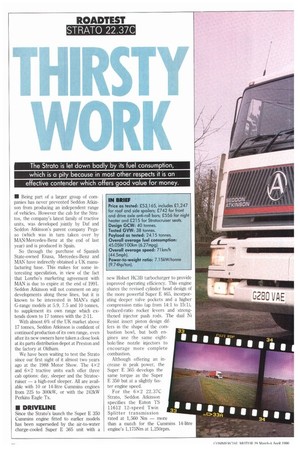
Page 32
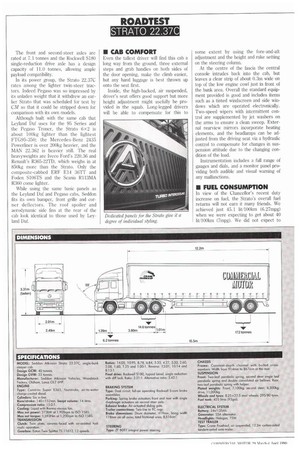
Page 33
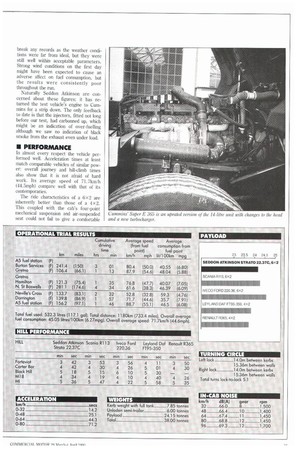
Page 34
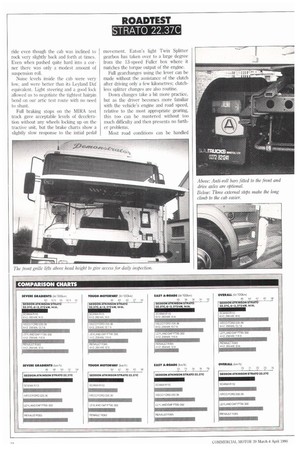
Page 35
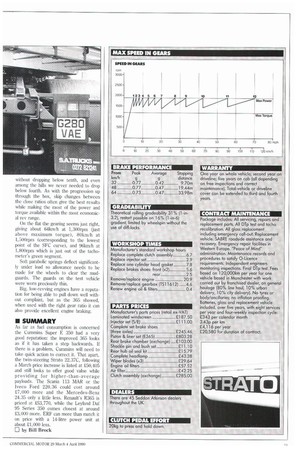
If you've noticed an error in this article please click here to report it so we can fix it.
The Stroto is let down badly by its fuel consumption, which is a pity because in most other respects it is an effective contender which offers good value for money.
• Being part of a larger group of com panies has never prevented Seddon Atkinson from producing an independent range of vehicles. However the cab for the Stra tos, the company's latest family of tractive units, was developed jointly by Daf and Seddon Atkinson's parent company Pegaso (which was in turn taken over by MAN/Mercedes-Benz at the end of last year) and is produced in Spain.
So through the purchase of Spanish State-owned Enasa, Mercedes-Benz and MAN have indirectly obtained a UK manufacturing base. This makes for some interesting speculation, in view of the fact that Lonrho's marketing agreement with MAN is due to expire at the end of 1991.
Seddon Atkinson will not comment on any developments along these lines, but it is known to be interested in MAN's rigid G-range models at 5.9, 7.5 and 10 tonnes, to supplement its own range which extends down to 17 tonnes with the 2-11.
With almost 6% of the UK market above 17 tonnes, Seddon Atkinson is confident of continued production of its own range, even after its new owners have taken a close look at its parts distribution depot at Preston and the factory at Oldham.
We have been waiting to test the Strata since our first sight of it almost two years ago at the 1988 Motor Show. The 4x2 and 6x2 tractive units each offer three cab options: day, sleeper and the Stratoc
raiser — a high-roof sleeper. All are available with 10 or 14-litre Cummins engines from 225 to 300kW, or with the 242kW Perkins Eagle Tx.
DRIVELINE
Since the Stratus launch the Super E 350 Cummins engine fitted to earlier models has been superseded by the air-to-water charge-cooled Super E 365 unit with a
new Holset HC3B turbocharger to provide improved operating efficiency. This engine shares the revised cylinder head design of the more powerful Super E 465, incorporating deeper valve pockets and a higher compression ratio (up from 14:1 to 15:1), reduced-ratio rocker levers and strengthened injector push rods. The dual Ni Resist insert piston design differs in the shape of the combustion bowl, but both engines use the same eighthole/fine nozzle injectors to encourage more complete combustion.
Although offering an increase in peak power, the Super E 365 develops the same torque as the Super E 350 but at a slightly faster engine speed.
For the 6 x 2 22.37C Strato, Seddon Atkinson specifies the Eaton TS 11612 12-speed Twin Splitter transmission rated at 1,560 Nin — more than a match for the Cummins 14-litre engine's 1,175Nm at 1,250rpm.
The front and second-steer axles are rated at 7.1 tonnes and the Rockwell S180 single-reduction drive axle has a design capacity of 11.0 tonnes, allowing ample payload compatibility.
In its power group, the Strato 22.37C rates among the lighter twin-steer tractors. Indeed Pegaso was so impressed by its unladen weight that it withdrew an earlier Strato that was scheduled for test by CM so that it could be stripped down for comparison with its own models.
Although built with the same cab that Leyland Daf uses for the 95 Series and the Pegaso Troner, the Strato 6x2 is about 100kg lighter than the lightest FIG95-350; the Mercedes-Benz 2435 Powerliner is over 200kg heavier, and the MAN 22.362 is heavier still. The real heavyweights are Iveco Ford's 220.36 and Renault's R365-22TD, which weighs in at 850kg more than the Strato. Only the composite-cabbed ERF E14 36TT and Foden S106TS and the Scania R113MA R360 conic lighter.
While using the same basic panels as the Leyland Daf and Pegaso cabs, Seddon fits its own bumper, front grille and corner deflectors. The roof spoiler and aerodynamic side fins at the rear of the cab look identical to those used by Leyland Daf.
• CAB COMFORT
Even the tallest driver will find this cab a long way from the ground, three external steps and grab handles on both sides of the door opening, make the climb easier, but any hand luggage is best thrown up onto the seat first.
Inside, the high-backed, air suspended, driver's seat offers good support but more height adjustment might usefully be provided in the squab. Long-legged drivers will be able to compensate for this to some extent by using the fore-and-aft adjustment and the height and rake setting on the steering column.
At the centre of the fascia the central console intrudes back into the cab, but leaves a clear strip of about 0.3m wide on top of the low engine cowl just in front of the bunk area. Overall the standard equipment provided is good and includes items such as a tinted windscreen and side windows which are operated electronically. Two-speed wipers with intermittent control are supplemented by jet washers on the arms to ensure a clean sweep. External rearview mirrors incorporate heating elements, and the headlamps can he adjusted from the driving seat via a hydraulic control to compensate for changes in suspension attitude due to the changing condition of the load.
Instrumentation includes a full range of gauges and dials, and a monitor panel providing both audible and visual warning of any malfunctions.
• FUEL CONSUMPTION
In view of the Chancellor's recent duty increase on fuel, the Strato's overall fuel returns will not earn it many friends. We achieved just 45.1 lit/100km (6.27mpg) when we were expecting to get about 40 liV100km (7mpg). We did not expect to break any records as the weather conditions were far from ideal, but they were still well within acceptable parameters. Strong wind conditions on the first day might have been expected to cause an adverse affect on fuel consumption, but the results were consistently poor throughout the run.
Naturally Seddon Atkinson are concerned about these figures; it has returned the test vehicle's engine to Cummins for a strip down. The only feedback to date is that the injectors, fitted not long before our test, had carbonned up, which might be an indication of over-fuelling although we saw no indication of black smoke from the exhaust even under load.
MI PERFORMANCE
hi almost every respect the vehicle performed well. Acceleration times at least match comparable vehicles of similar power: overall journey and hill-climb times also show that it is not afraid of hard work. Its average speed of 71.7km/h (44.5mph) compare well with that of its contemporaries.
The ride characteristics of a 6x2 are inherently better than those of a 4 x 2. This coupled with the cab's four-point mechanical suspension and air-suspended seat could not fail to give a comfortable ride even though the cab was inclined to rock very slightly back and forth at times. Even when pushed quite hard into a corner there was only a modest amount of suspension roll.
Noise levels inside the cab were very low, and were better than its Leyland Daf equivalent. Light steering and a good lock allowed us to negotiate the tightest hairpin bend on our artic test route with no need to shunt.
Full braking stops on the MIRA test track gave acceptable levels of deceleration without any wheels locking up on the tractive unit, but the brake charts show a slightly slow response to the initial pedal
movement. Eaton's light Twin Splitter gearbox has taken over to a large degree from the 13-speed Fuller box where it matches the torque output of the engine.
Full gearchanges using the lever can be made without the assistance of the clutch after driving only a few kilometres; clutchless splitter changes are also routine.
Down changes take a bit more practice, but as the driver becomes more familiar with the vehicle's engine and road speed, relative to the most appropriate gearing, this too can be mastered without too much difficulty and then presents no further problems.
Most road conditions can be handled
without dropping below tenth, and even among the hills we never needed to drop below fourth. As with the progression up through the box, skip changes between the close ratios often give the best results while making the most of the power and torque available within the most economical rev range.
On the flat the gearing seems just right, giving about 64km/h at 1,300rpm (just above maximum torque), 80kmih at 1,500rpm (corresponding to the lowest point of the SFC curve), and 96km/h at 1,800rpm which is just out of the tachometer's green segment.
Soft parabolic springs deflect significantly under load so allowance needs to be made for the wheels to clear the mudguards. The guards on the test vehicle were worn preciously thin.
Big, low-revving engines have a reputation for being able to pull down well with out complaint, but as the 365 showed, when used with the right gear ratio it can also provide excellent engine braking.
• SUMMARY
As far as fuel consumption is concerned the Cummins Super E 350 had a very good reputation: the improved 365 looks as if it has taken a step backwards. If there is a problem, Cummins will need to take quick action to correct it. That apart, the twin-steering Strato 22.37C, following a March price increase is listed at 250,405 and still looks to offer good value while providing for higher-than-average payloads. The Scania 113 MAR or the lveco Ford 220.36 could cost around 27,000 more and the Mercedes-Benz 24.35 only a little less. Renault's R365 is priced at 253,770, while the Leyland Daf 95 Series 350 comes closest at around 23,000 more. ERF can more than match it on price with a 14-litre power unit at about 21,000 less.
D by Bill Brock




































































































































































